'World-class' facility upgrades at Vet Med campus are nearly complete
Dr. Lisa Nolan, the Dr. Stephen G. Juelsgaard Dean of Veterinary Medicine, says there's nothing like it in the country. When seven years of phased construction and an investment of nearly $100 million in the College of Veterinary Medicine campus wraps up later this summer, the college will have added about 40 percent more space to its 1976 facility and renovated more than a third of existing space.
In another $18 million of utility improvements, the chilled water and steam generator plants were replaced with high-efficiency systems now independent of central campus, and electrical capacity was expanded significantly.
"We have a world-class facility here," Nolan said. "There are others making big investments, don't get me wrong, but I don't think our facilities are second to anybody right now. It's a really special place."
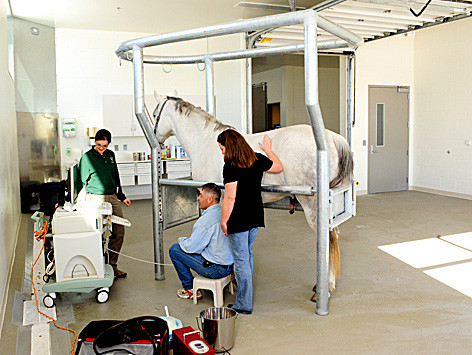
An ultrasound is performed on the front leg of one of the first equine patients admitted to the new large animal hospital in Februrary 2009. File photo by Bob Elbert.
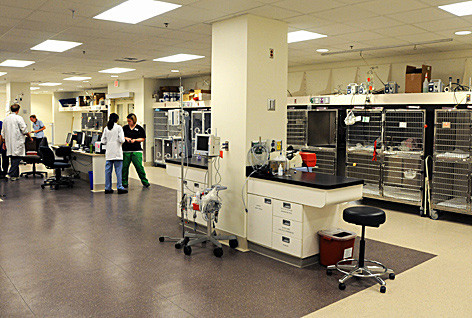
The spacious intensive care unit in the small animal hospital, pictured the week it opened in July 2011. File photo by Bob Elbert.
Facility highlights
In the new spaces, the college has a state-of-the-art large animal hospital to provide care for horses, beef and dairy cows, swine, sheep, goats, llamas and more; dozens of day-lit faculty offices; additional rooms for teaching; an indoor riding arena to assess the health and gait of horses and a field services building, the home base for an expanded mobile veterinary service to Ames-area large animal producers.
In renovated space, the small animal hospital more than doubled in size. Upgrades to the state's only accredited veterinary diagnostic laboratory included converting a biosafety level 2 laboratory into a level 3 laboratory to test animal samples and animals potentially infected with highly infectious diseases. The lab processes more than 40,000 samples each year from livestock producers, helping them raise healthier herds.
That diversity is another feature that sets Iowa State's veterinary medicine program apart from many of the other 27 schools in the country.
While crowded conditions – for employees, for students, for animals – had been a key shortcoming with the Vet Med complex, Nolan is quick to point out that the changes aren't just about having more space. It's modern and thoughtfully planned space -- reflecting faculty and staff ideas and analysis of other facilities -- that contains state-of-the-art equipment, some of which didn't even exist in 1976. Like human medicine, veterinary medicine continues to evolve and specialize, Nolan said. And in part because of human medicine, animal owners' expectations about care for their animals have changed. Iowa State veterinarians can perform full hip replacement surgery on dogs, complete embryo transfers in cows or do MRI and 16-slice CT scan on small animals, for example. Dermatology, neurology, cardiology, radiology, anesthesiology, orthopedic surgery, reproductive medicine . . . ISU faculty are board-certified in 17 specialties, some of which not so long ago were reserved for human patients.
"Our facilities help us recruit talented faculty whose expertise allow us to give students a really broad background for a career in veterinary medicine. I'm really proud of that," Nolan said.
Where are they now? Iowa State's DVM class of 2011*
| Veterinary practice | 84% |
| Food animal | 23% |
| Companion animal | 38% |
| Equine | 6% |
| Mixed practice | 17% |
| Corporate | 5% |
| Advanced education | 11% |
*143 DVM graduates
Source: American Veterinary Medicine Association
A hospital for students
The large and small animal hospitals that make up the Lloyd Veterinary Medical Center are teaching hospitals first. The surgery and treatment rooms include ample space for students to observe. The surgical suites also include digital cameras that capture the procedure, which can be shown on large plasma screens in the operating room or transmitted to a classroom elsewhere in the building. Some of the 22 small animal exam rooms include two-way mirrors so students' interactions with clients can be evaluated.
"We can give our students a much better experience now," Nolan said. And prospective students know it. "This year, we had over 1,100 applicants for 120 slots. We have to turn down a lot of qualified applicants who would make good veterinarians, but we just can't train them all."
Through a contract with the University of Nebraska, Lincoln, Iowa State also admits 25 Nebraska students annually, and for the final two years of their veterinary medicine program they're in Ames. The class of 2011 was the first to include a Nebraska contingent.
Motivated to invest in facilities
2004 -- the 125th anniversary of what is the country's first college of veterinary medicine – was significant for another reason. Following an accreditation site visit the year before, the college received a limited accreditation from the American Veterinary Medical Association, pending a follow-up review in 2006. A key shortcoming cited by the review team was the poor quality of about half of the space in the teaching hospital and diagnostic laboratory, including issues with air quality, deferred maintenance and crowded working conditions.
College leaders had begun planning for renovations a couple years earlier, but that review moved the process forward rapidly.
Nolan had just joined the Iowa State faculty in 2003 (she became an associate dean in 2007 and dean in January 2011).
"[Limited accreditation] was a great incentive to change things, and it motivated a lot of people – including alumni (the college has nearly 7,000) and legislators.
"Under (former Vet Med) dean (John) Thomson, it all started to come together," she said.
In the spring of 2004, Iowa State secured bonding authority from the Legislature to begin renovations. The program returned to full accreditation in spring 2007 and was reaccredited in 2010.
Faculty numbers on the rise
The new facilities and the enrollment growth both have contributed to a growth in faculty numbers at the college. From 2005 to 2011, faculty numbers grew from 155 to 185.
"A lot of our faculty could be anywhere," Nolan said. "They come here for a variety of reasons; maybe because the teaching is important to them or being able to work at the cutting edge of clinical medicine or research, is important to them. Regardless of the reason, they're excited to be here."
No cygnets for Iowa State's iconic swans
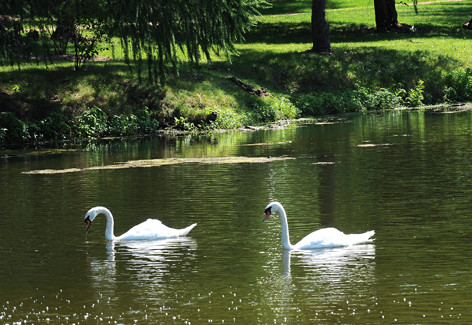
Lancelot and Elaine on Lake LaVerne. Photo by Bob Elbert.
Realistically, we know that Lancelot and Elaine aren't the original pair of swans first introduced to Lake LaVerne in 1935. But it might not be common knowledge that both swans are female.
"We are 90 percent to 99 percent sure they are both females," said Cathy Brown, assistant director for campus planning in facilities planning and management. "It is difficult to verify the sex of swans, even for the experts."
Swan history
- Veishea brief
- 1938 footage (2:49)
- Ethos article (1998)
- Excerpt (date unknown)
Causing a stir
The current swans have created a buzz by nesting more persistently over the last five years. They started out nesting close to the lake, but branched out to more public spots near the sidewalks and the Memorial Union. Nick Van Berkum, communications specialist in the sociology department, filmed and posted a YouTube video of their nesting activities last year.
Although both swans are nesting, the eggs are not expected to be fertile and are not likely to hatch. Brown said FPM staff remove the eggs and disperse the nest after an appropriate amount of time.
"If we remove them too early, the swans will keep laying eggs later into the summer," Brown said. "This is a passive way to manage the swan population."
Swan evolution
A pair of mute swans was introduced onto Lake LaVerne in 1935. In 1995, the state Department of Natural Resources asked the university to try trumpeter swans as part of its efforts to reintroduce the once-native bird to Iowa.
In 1999, the use of trumpeters was discontinued because of their wandering (fearless of traffic) and aggressive nature, and were replaced by mute swans, which tend to spend more time on the water. Nonbreeding mute pairs are being used to prevent reproduction of the non-native species. FPM staff switched to this current female duo in 2003 after the male swans developed aggressive tendencies as they matured.
Search begins for next Engineering dean
The search for the next dean of the College of Engineering is under way. Executive vice president and provost Elizabeth Hoffman on July 3 identified a 20-member search committee to seek a successor to Jonathan Wickert, who will become senior vice president and provost on July 30.
Co-chairing the search committee are David Holger, associate provost for academic programs and dean of the Graduate College; and Luis Rico-Gutierrez, dean of the College of Design. Penni Bryant, administrative specialist in the provost's office, will assist the committee with its work.
The search committee will begin its work this summer by soliciting nominations from across engineering disciplines. Nominations may be submitted to Holger, Rico-Gutierrez and Bryant.
Mufit Akinc, professor of materials science and engineering and an associate scientist for the U.S. Department of Energy's Ames Laboratory, will serve as interim dean beginning July 30.
Search committee
Additional members of the search committee are:
- Peggy Boylan-Ashraf, senior lecturer, aerospace engineering
- Sandy Bremer, teaching lab coordinator, mechanical engineering
- Ian Dobson, Arend and Verna Sandbulte Professor, electrical and computer engineering
- Rachel Dudley, graduate student, mechanical engineering
- Shauna Hallmark, professor, civil, construction and environmental engineering
- Mark Henthorn, vice president, Stanley Consultants, and chair, College of Engineering Industrial Advisory Council
- Hui Hu, associate professor, aerospace engineering
- Cynthia Jenks, assistant director for scientific planning and division director of chemical and biological sciences, U.S. Department of Energy Ames Laboratory
- Joel Johnson, director of student engagement, College of Engineering
- Song-Charng Kong, associate professor, mechanical engineering
- Adam Laug, development director, Iowa State University Foundation
- Austin Laugen, president, Engineering Student Council, and undergraduate student, computer engineering
- Diane Meyer, program coordinator, Engineering Research Institute, College of Engineering
- Gary Mirka, associate dean for education, and John Ryder Professor and Chair, industrial and manufacturing systems engineering
- Ralph Napolitano, chair, Engineering Caucus of the Faculty Senate, and the Al and Julie Renken Professor of materials science and engineering
- Michael O'Donnell, industrial specialist, Center for Industrial Research and Service, extension and outreach
- Brent Shanks, director, NSF Engineering Research Center for Biorenewable Chemicals and the Mike and Jean Steffenson Professor of chemical and biological engineering
- Michelle Soupir, assistant professor, agricultural and biosystems engineering
- Janis Terpenny, Joseph Walkup Professor and Chair, industrial and manufacturing systems engineering
- Pat Thiel, Distinguished Professor in Liberal Arts and Sciences, the John D. Corbett Professor in Chemistry, professor of materials science and engineering, and a faculty scientist with the U.S. Department of Energy's Ames Laboratory
Back from D.C., exhibit headed to state fair
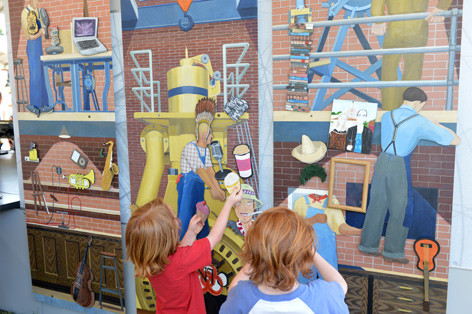
Youngsters help recompose panels from the Grant Wood mural, familiar to Parks Library users. More festival photos. Photo by Kanji Takeno.
It was a busy couple of weeks for Iowa Staters staffing the university's exhibit on the National Mall in Washington, D.C. An estimated one million visitors braved the 100-plus degree temperatures to attend the annual Smithsonian Folklife Festival in late June and early July.
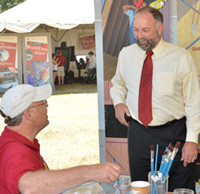
President Leath talks with C. Arthur Croyle, associate professor of integrated studio arts. Other visitors included executive vice president and provost Elizabeth Hoffman and Engineering dean Jonathan Wickert. Photo by Kanji Takeno.
One piece of this year's festival celebrated the 150th anniversary of the signing of the Morrill Act, which laid the foundation for land-grant universities. Iowa State was one of 17 universities selected to represent the land-grants.
Iowa was the first state to accept the terms of the historic Morrill Act, so it was fitting that Iowa State be a part of the national celebration, said Cathann Kress, vice president for extension and outreach.
Iowa State's exhibit showed how faculty, staff and students have applied design thinking to help Iowa communities solve problems. The partnership between the College of Design and ISU Extension and Outreach was echoed throughout the interactive exhibit.
See exhibit at state fair, Farm Progress Show
The exhibit will be on display again at the Iowa State Fair (Des Moines, Aug. 9-19) and the Farm Progress Show (Boone, Aug. 28-30).
Project leaders
Iowa State's project was led by Chitra Rajan, associate vice president for research; Cathann Kress, vice president for extension and outreach; and Luis Rico-Gutierrez, dean of the College of Design. Sandra Norvell, Center for Excellence in the Arts and Humanities, coordinated the project development. David Ringholz, associate professor and chair of industrial design, led the exhibit design team. Lisa Fontaine, associate professor of graphic design, led the exhibit content team. Information Technology Services provided technical assistance. More than a dozen people staffed the exhibit.
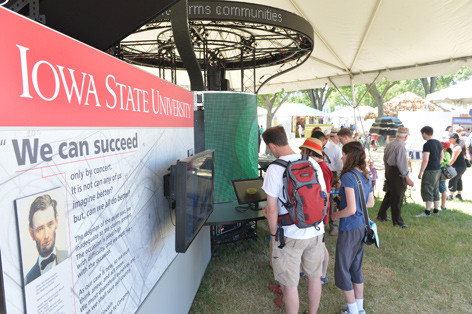
Visitors stop by Iowa State's exhibit in the Smithsonian Folklife Festival. Photo by Kanji Takeno.
Wanted: Your old Tidy Cats containers
Tidy Cats cat litter users can help pilot a glass recycling effort on campus this summer simply by bringing in their empties. University officials and scientists hope the pilot program will prove to be an effective way to keep broken, discarded glass from Iowa State labs out of the Ames Resource Recovery Plant.
"Glass isn't useful in the production of electricity at the recovery plant, and it causes considerable wear on plant machinery," director of sustainability Merry Rankin said. "The city is asking for our help in keeping glass out of our trash.”
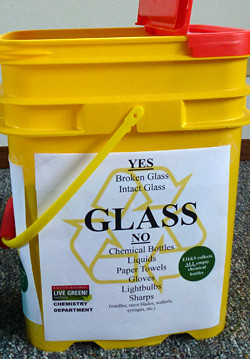
Summer test
The proposed solution, which will be tested this summer, is to place identical large, yellow containers in labs for glass waste. The containers are yellow to match the City of Ames glass recycling bins that will be placed on loading docks of pilot buildings. Filled Tidy Cat containers will be emptied into the Ames bins, and facilities planning and management staff will transport the collected glass to the city for recycling.
Thrifty, and green
Initially, university officials intended to buy containers for the lab. However, they couldn't find anything in the preferred size and color.
Amanda Jacobson, a spring graduate and summer intern working on the glass waste program, had a thrifty idea: Slap labels on Tidy Cats buckets (pictured). They meet size and color requirements and could be acquired free from cooperative cat owners. Additionally, reusing containers destined for garbage will make the glass recycling project even more green.
Where to donate
All that's needed now is donations of old Tidy Cats containers -- with lids intact, rinsed out and dry. Partners in the glass recycling project (facilities planning and management, environmental health and safety, and the Live Green program) have set up two drop-off points:
- 108 General Services Building, Merry Rankin's office
- Environmental Health and Safety Services Building, front desk (7:30 a.m.-4 p.m. during the summer)
1,800 labs = lots of glass
With some 1,800 labs, Iowa State generates considerable amounts of discarded glassware, including, pipettes, slides, and petri dishes.
"There's great potential here for recycling a lot of glass," Rankin said.
Coming to a court or field near you: Iowa Games
The arrival of hot temperatures and high humidity in July signals at least one thing. Yes, it's Iowa Summer Games time.
While the games opened last weekend with about a half dozen events, including tough outdoor contests such as road cycling, ultimate Frisbee and the triathlon, a majority of events will be held July 12-15 and July 20-22. And many of them will take place on campus, in Ames or at nearby central Iowa venues.
Opening celebration
Regardless of when they compete, athletes and their families are invited to participate in an opening ceremony Friday, July 13, in the parking lots along the east side of Jack Trice Stadium. The 30-minute ceremony begins at 7 p.m. with a parade of athletes, and will be followed by a two-hour concert featuring country music artists The Lost Trailers (8:30 p.m.) and special guest Sunny Sweeney (7:30 p.m.). These events are free and open to the public.
A jamboree for athletes (5:30-9 p.m., Lot S6) will offer inflatable games, climbing wall, zip line, photo booth, motorcycle exhibition, an acrobatic performance by Chicago Boyz and a free meal (5:30 p.m.) for the first 2,200 athletes.
Weekend impact on recreation facilities
Both the east and west gymnasiums in State Gym and the main floor of the Lied Center will be closed July 13-15 for Iowa Games competitions. The pools in both State Gym and Beyer Hall will be closed July 14-15, also for Iowa Games events.
Union Drive closed at MU
If you'll be navigating campus as a participant or fan, you're reminded that the ongoing concrete road pavement replacement moves to Union Drive on the north side of the Memorial Union on Thursday, July 12. The road closes that day and will remain closed for two weeks. One traffic lane will be kept open for CyRide buses only. The roadwork will block the north entrance to the MU parking ramp, so ramp access will be only from the Lincoln Way (south) entrance.
The pavement replacement work on Beach Road between Lincoln Way and Wallace Road is on schedule to wrap up this week. Construction barricades along that route should be removed late Friday afternoon.
Full slate
Perhaps you knew there were "a lot" of Iowa Games sporting events in central Iowa this month, but did you realize the volume? Here's a quick rundown of which competitions occur over four weekends:
|
July 7-8 Cycling: Gravel road race, tour ride Golf: Par 3 Handball Strongman competition Triathlon Ultimate Frisbee
July 12-15 Archery, 3D Archery Badminton Baseball: 10U, Adult Basketball: 3-on-3, 5-on-5, adult men, shooting Billiards BMX Bowling Canoe/Kayak Cycling: Mountain biking, road race and time trial Disc golf Equestrian Fencing Fish casting (indoors) Fitness walk Golf: Adult, juniors, Pee Wee and 4-person best shot Judo Pickleball Racquetball Road Race: Midnight Madness |
July 12-15 (cont.) Rugby Shooting: multiple categories Soccer: Youth Softball: Youth Swimming: Masters and youth Table tennis Taekwondo Tennis: Adult and youth Track and field: Adult and youth Volleyball Weightlifting
July 20-22 Baseball: 12U, 14U Cross country race Dodgeball Figure skating Flag football: Adult Golf: 2 person Horseshoes Sand volleyball Shooting: Cowboy Action Soccer: Adult Softball: Adult Wrestling
July 28-29 Basketball: Women's 6-on-6 Diving Water skiing |
